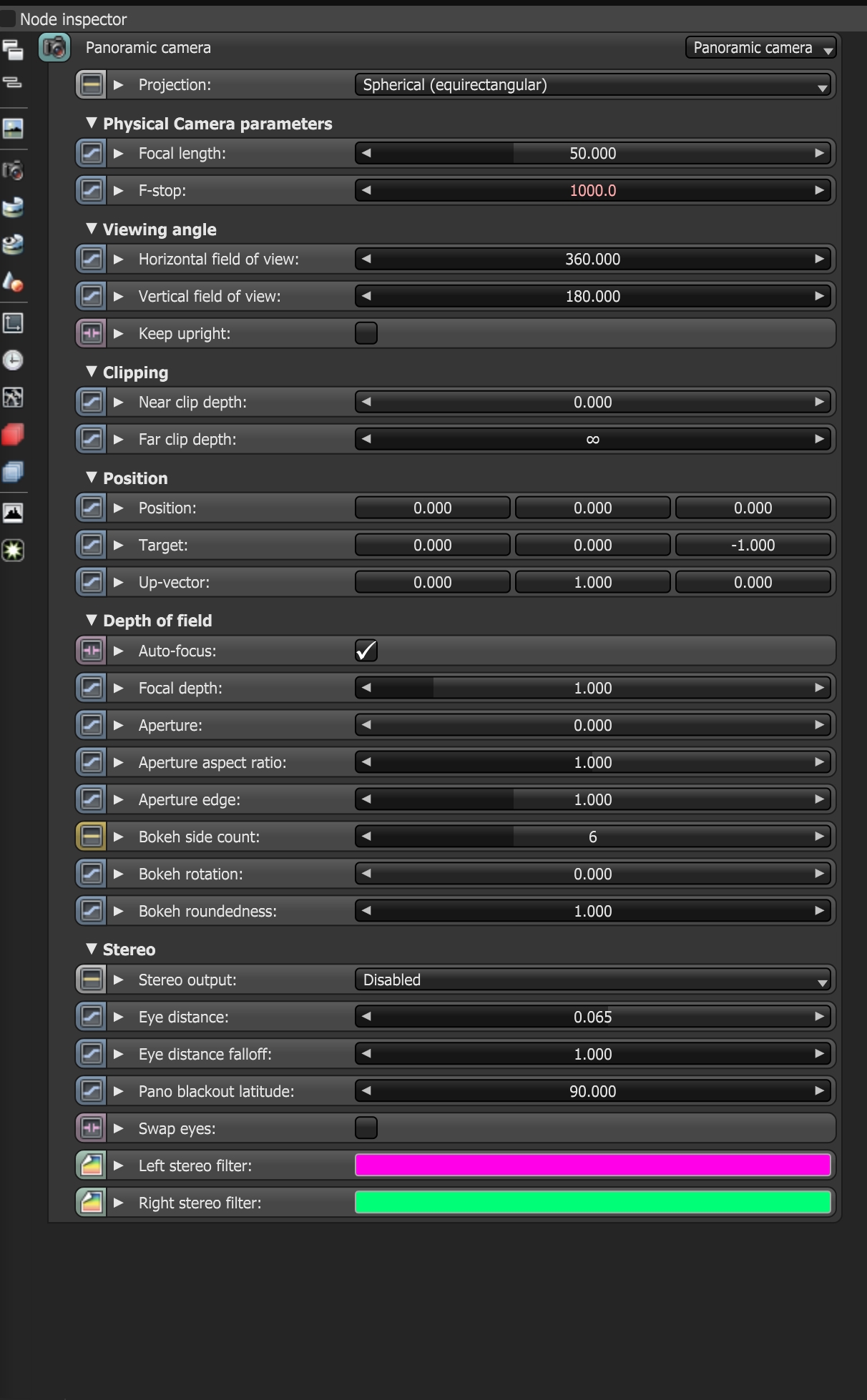Panoramic
The Panoramic camera is used for rendering VR-related images. There are three types of Panoramic cameras available: Spherical, Cylindrical, and various Cube Map types (+x, -x, +y, -y, +z, -z).
|
|
Panoramic Parameters
|
Figure 1: Panoramic camera parameters
Panoramic Camera Parameters
Projection - Choose between a Spherical or a Cylindrical camera lens to use as the panoramic projection. Full-sized faced and single-face Cube Map projections are available to render all faces or one face of the cube. This is useful for animation overlays in stereo panorama renderings.
Physical Camera Parameters
Focal Length - The lens focal length, in millimeters.
F-Stop - This is the aperture to focal length ratio.
Viewing Angle
Horizontal Field of View - The horizontal field of view, in degrees. This sets the X-coordinate for the camera's horizontal field of view in the scene. This is ignored when cube mapping is used.
Vertical Field of View - The vertical field of view, in degrees. This sets the Y-coordinate for the camera's vertical field of view in the scene. This is ignored when cube mapping is used.
Keep Upright - The panoramic camera always orients towards the horizon, and the up-vector stays in its default vertical direction (0, 1, 0).
Clipping
Near Clip Depth - The distance from the camera to the nearest clipping plane, in meters.
Far Clip Depth - The distance from the camera to the farthest clipping plane, in meters.
Position
Position - The camera's position in the scene in world space.
Target - The target position where the camera points to in the scene.
Up-Vector - This is the up direction of the camera in the scene. The default direction is in the Y-direction (0, 1, 0).
Depth Of Field
Auto-Focus - Focus is kept on the closest visible surface at the center of the image, regardless of the Aperture, Aperture Edge, and Focal Depth values.
Focal Depth - The focal area's depth, measured in meters.
Aperture - The camera lens opening's radius, measured in centimeters. Low values create a wide depth-of-field, where everything is in focus. High values create a shallow depth-of- field, where objects in the foreground and background are out of focus.
Aperture Aspect Ratio - Squashes and stretches the depth-of-field disc.
Aperture Edge - Controls aperture edge detection at all points within the aperture, and modifies the bokeh effect. Lower values produce more pronounced edges to out-of-focus objects affected by a shallow depth-of-field, such as objects in the foreground and background. High values increase the contrast.
Bokeh Side Count - The number of edges making up the bokeh shape.
Bokeh Rotation - The bokeh shape's orientation.
Bokeh Roundedness - The roundness of the bokeh shape's sides.
Stereo
Stereo Output - Enables stereo mode and specifies which of the following stereo outputs to render with.
- Left - Renders the left eye image.
- Right - Renders the right eye image.
- Side-By-Side - Renders the scene as a pair of two-dimensional images.
- Anaglyphic - Renders are viewable with red/blue 3D glasses.
- Over-Under - The pair of two-dimensional images is placed one above the other for special viewers.
Eye Distance - The distance between the left and the right eye in stereo mode, measured in meters.
Eye Distance Falloff - This controls how fast the eye distance reduces towards the poles. This reduces eye strain at the poles when the panorama is viewed through a head-mounted display.
Pano Blackout Latitude - This is the +/- latitude where the panorama cuts off when stereo rendering is enabled. This defines the minimum latitude (in spherical camera coordinates) where the rendering blacks out above this point.
Swap Eyes - This swaps the left and right eye positions when stereo mode shows both.
Left Stereo Filter/Right Stereo Filter - The left and right filter colors that create the anaglyphic stereo effect in the render.

